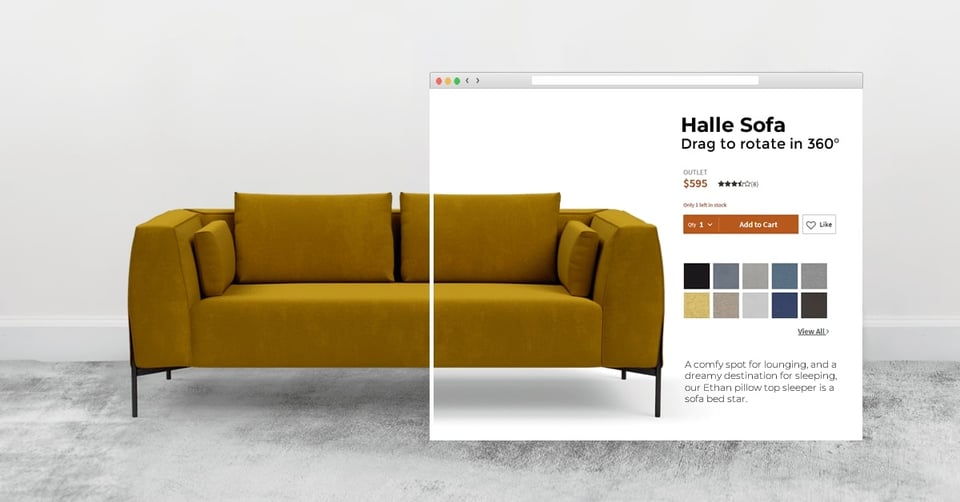Key Points:
-
COVID-19 as a Digital Catalyst: The pandemic dramatically accelerated the shift to online shopping, exposing traditional retailers who lacked digital infrastructure while boosting tech-savvy brands and digital-native companies.
-
The Power of Direct-to-Consumer (DTC): The DTC model creates resilience by allowing brands to control the entire customer journey—from design and pricing to data ownership—resulting in better margins and stronger brand loyalty.
-
Technology is the Differentiator: Successful DTC adoption requires a robust tech stack, including 3D product visualization software and Augmented Reality (AR), to replace the in-store experience and meet modern consumer expectations for customization and convenience.
COVID-19 has had dramatic effects on consumer behavior and shopping patterns across every category. Furniture is no exception.
We could witness a major shift to online shopping. The new “stay at home” way of life has forced consumers to shop online. Tech-savvy furniture retailers were better prepared for this scenario, as they were already utilizing online features as one of their sales channels.
Unfortunately, many furniture businesses that were delaying digital transformation efforts have been caught flat-footed, without the ability to deliver a positive digital experience.
On the other hand, furniture brands were scrambling to solve supply chain issues and to find new retail partners. Many started contemplating testing the direct-to-consumer (DTC) business model.
The Impact of COVID-19 on the Furniture Industry
The last couple of months were game-changing for the furniture industry. Even though the coronavirus outbreak had a significant impact on retail sales because stores were closed, we can’t deny that this was also a catalyst for change.
The new situation has debunked the myth that you can’t sell every product online. According to Statista, websites selling home decor and furniture products online generated 1.7 billion visits in March 2020, up from 1.56 billion global visits in January 2020.
Data from ACI Worldwide shows that in March 2020, online transaction volumes increased by 97% for home products and furnishings, when compared to March 2019.
Aware of the situation, furniture retailers are adopting strategies that will help them respond to behavioral change on a global level. According to a survey conducted by Furniture Today, 69% of responding furniture retailers plan to focus more on e-commerce in response to the COVID-19 virus.
Traditional retailers that were focused on in-store sales, neglecting the importance of online sales, are now rushing to create an engaging online presence and e-commerce website.
Other retailers that had an online store before the outbreak are embracing different tactics that can help them step-up their e-commerce furniture game and set a foundation for future growth.
What is the Direct-To-Consumer Business Model?
The DTC business model refers to selling products directly to consumers, bypassing distributors, traditional retail stores, and other middleman channels.
What makes this self-reliant concept so special is the fact that the company is handling every step of the process – from design and production to sales and delivery.
The DTC model is nothing new. It’s been around for a decade now. Companies like Warby Parker, Everlane and Casper, were among the first to test the waters, relying on web-only retail, direct distribution, distinctive visual identity, and social media marketing.

Fast forward to today, competition in the DTC segment is fierce, and companies realized that they must evolve to stay relevant. So instead of web-only, you can also see DTC brands embracing pop-up stores, partnering with retailers, and opening flagship stores.
Three major factors paved the way for widespread adoption of the DTC model:
- Technology - Today, reaching consumers directly is easier and cheaper than ever before, thanks to technology.
- The rise of digital-native brands - The success of digital-native brands such as Interior Define, Burrow, Article, and Joybird has shown that the DTC business model has great potential in the furniture industry.
- The shift in consumer expectations - Consumers have high expectations from brands. According to Salesforce:
- 73% of consumers expect to be able to buy directly from a brand as well as from a retailer;
- 76% of consumers expect the same level of engagement when buying from a brand as when buying from a retailer;
- Nearly half of consumers buy at least one product directly from a brand on a regular basis, and 44% expect to buy more products directly from brands in the future.
In the Direct-to-Consumer Brands 2020 report, eMarketer forecasts that DTC sales will account for $17.75 billion of total e-commerce sales in 2020, which is a 24.3% increase from the previous year. They also estimated that there will be 87.3 million D2C e-commerce buyers in 2020, up 10.3% from the prior year.
How Do Furniture Brands Win with the DTC Model?
For DTC furniture businesses, the COVID-19 outbreak was the first major resiliency test. At the beginning of March, when the World Health Organization declared a global pandemic, there were many predictions that DTC businesses wouldn't make it to the other side.
While this may be true for DTC brands that were betting on the pay-for-play growth, forward-thinking DTC brands that put customer experience at the core of their businesses turned the situation in their favor.
The Canadian DTC furniture brand Article shared that their sales went up 200% in April of 2020 when compared to the same period last year, giving them their highest revenue month to date.
Around a thousand miles south of Article, the Utah-based mattress DTC brand Purple Innovation, revealed that their May direct-to-consumer orders increased 125% to approximately $71 million when compared with the same month last year.

The fact that digitally-native DTC brands have online sales at the core of their business model is one of the reasons why most of them coped well with the shift in consumers’ behavior.
One of the fastest-growing DTC furniture brands, Sofacompany, set the foundations for a successful business way before the COVID-19 situation developed. Having an engaging online presence and good processes in place made them resilient to the impact of the coronavirus outbreak.
Why Should Furniture Brands Test the DTC Concept?
The DTC model marries high-quality product design with direct-to-consumer convenience. Customers today have much higher expectations from furniture companies.
“All of the sudden, people don’t want to wait six to 12 weeks for their furniture, they don’t want to hire movers, and they expect something more from their consumer experience than just the relief of finally getting it set up inside their homes.” - Ben Parsa, CEO at Inside Weather for Curbed.
If we look at the benefits of DTC companies, it’s easy to see why many furniture brands are considering this strategy.
Strong brand image
While there are significant advantages when selling through a retailer network, there are also some things that you have to compensate for. The brand is one of them. Even though you’re not selling white label products to your retailers, the fact that you don’t have control over the communication with customers takes away a part of your brand image.
DTC brands communicate directly with customers, so they can tell their brand story exactly as they envision it. On top of that, they also get customer feedback in real-time.
Data ownership
Even if we put aside cheesy phrases like “data is the new oil,” we can’t deny the fact that data can be the most powerful weapon a brand can have. Today with such advanced analytics tools, making decisions based on a “gut feeling” can cost you business continuity.
Unlike furniture brands, DTC companies have ownership of the overall CRM, sales, and customer support data. Being able to analyze customer behavior, purchasing trends, and customer feedback can help you make better decisions across the board—from product development to marketing, sales, and customer support.
Today when personalization is everything, having insights about who your customers are and what they want, can help you personalize your approach and get more conversions.
End-to-end customer experience
No matter how creative your digital merchandising ideas are, you can’t control the user experience that your retailers create for the clients. DTC brands, on the other hand, have full control over the customer experience from beginning to end.
Having a superior, flawless, and smooth user experience is one of the main pillars of successful DTC furniture brands. Equipped with a product configurator, 360-views, product recommendations, user-generated content, and customer reviews—they have the perfect product page that converts.
The freedom that the DTC model gives to furniture brands goes a long way.
Improved pricing control
When you don’t sell directly to end customers, you don’t have control over the final price. With this, not only profit margin is at stake, but also how you want to position your products.
The DTC model gives you a wider perspective of the overall costs and lets you optimize to the point where you can decide on the price for different product lines. No matter if you want to focus on affordable products or include high-end products with higher prices, with DTC, you have full control over your pricing strategy.
🚫Stop Guessing What Your Customers Want
DTC brands own their data, meaning they know exactly what sells. Ready to see the technology that makes this possible?
5 Strategies to Successfully Move to DTC
Now that you’re aware of all the benefits of going DTC, it’s time to take a look at some of the strategies and key aspects you should consider further down the road.
1. Understand your customers’ needs
First things first. Going DTC means there is no intermediary between you and the customers. This implies that you are in charge of getting to know your customers, understanding their needs, and addressing their concerns.
Before moving to the next step, you need to decide on the following aspects:
- Define your target audience
- Understand their needs
- Analyze your competitors
- Create clear brand positioning
2. Create a product offering that resonates with your customers
The best thing about the DTC model is that you get to know what customers want and focus on things you do best. Most of the successful DTC companies have a niche that they know well, and they can offer extra value for their customers. No matter if it’s a sofa, mattress, or outdoor furniture, starting with something that you’re really good at, then slowly expanding your offerings as you gain customers’ trust is the best way to grow your DTC furniture business.
3. Choose the right tech stack
All successful DTC furniture brands out there are tech-savvy, and they use technology to create engaging shopping experiences. Creating an efficient tech stack requires thoughtful thinking.
Some of the technologies that companies have to adopt if they want to test the DTC model include a strong e-commerce platform, product visualization, CRM and marketing software, order fulfillment, a data analytics stack, and personalization engines.
One company that relies on technology to grow its business is Sofacompany. Using 3D product visualization and augmented reality has helped them boost engagement on their website, increase conversions, and reduce visualization costs, a huge difference when compared with what they had for product photography.
DTC brands are digitally-native, so using technology as a competitive advantage is expected. Customers today are comparing you to the best digital experiences
they’ve ever had, constantly raising their expectations bar. Technology can help you future-proof your business and make you more resilient in similar outbreak scenarios in the future.
4. Avoid channel conflict
One of the biggest concerns that furniture brands have when deciding whether they should move into the uncharted DTC territory is channel conflict.
Should you be worried about this? Well, full disclosure, selling the same products that your retailers sell, at different prices may cause price wars, and even lead to losing the trust of your customers, and/or your retailers.
There are two ways to avoid channel conflict:
- Exclusive offering—Create a dedicated offering that you will sell exclusively on your e-commerce site.
- A new DTC brand—Many furniture brands avoid the channel conflict by creating a separate DTC brand. This way, you can check the pulse on the market without jeopardizing the relationship with your retailer network.
5. Focus on creating an unparalleled customer experience
If you are considering the DTC business model, have in mind that the only way to succeed is to create an outstanding customer experience. If you think that you can jump into a sea of sharks, and play by their rules, you stand no chance.
If there is one thing that DTC brands can do best, that’s using creativity to exceed expectations. So instead of following what retailers do, make sure to create your own rules and raise the bar in customer experience.
Wrap up
Over the past few years, brands have increasingly embraced the direct-to-consumer business model alongside traditional retail. Thanks to technology, the rise of digital-native brands, and the shift in consumers’ expectations, today, we’re witnessing successful DTC furniture brands with remarkable online shopping experiences.
Want to know how 3D product visualization can help you on the road to DTC?







